Contemplative Times, Issue # 7
The Newsletter of Meditation Chapel
The Meditation Chapel Vision
Meditation Chapel nurtures unity and world peace through the sharing of divine stillness and sacred listening. We support groups of all faith traditions in offering and sharing the contemplative experience through the sacramental use of technology.
Letter from the Editor by Laura Waters
An Elder said, “Just as a tree cannot bear fruit if it is often transplanted, so neither can a monk bear fruit if he frequently changes his abode.” ~ XXVII The Wisdom of the Desert, Thomas Merton
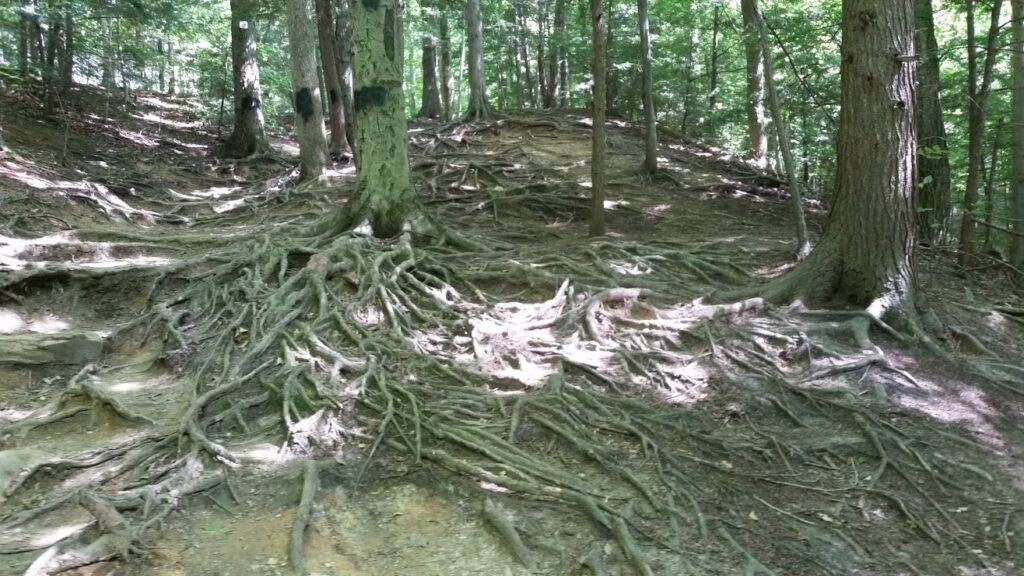
Photo by Laura Waters
At the time of writing, the world is in its eighth month of the Covid-19 pandemic. People everywhere have died, suffered the loss of loved ones, lost jobs, and are somehow learning to navigate and adapt to all the changes to daily living. A pandemic alone is enough to adjust to, but add to that political upheaval, civil unrest, and long-needed reform of not only justice systems worldwide, but also in how we treat each other and our Earth. We’re dealing with a lot.
With all of that in view, the idea of stability and rooted-ness drew my attention. Specifically, how are we “rooted and established in love” according to Ephesians 3:17?
Allowing myself to let go of time and some loose obligations, I journeyed with Spirit to explore this question. What I found involved more of what I started with – LETTING GO. Letting go of how I think I am rooted, and trusting that I am rooted. Letting go of being rooted in a place, and becoming rooted in my own soul. Letting go of mourning the lack of physically being together, and enjoying the opportunities of extended solitude (and attending more online gatherings at Meditation Chapel!). Letting go of busyness and external commitments, and rooting (rerouting?) my practices in my commitment to Source.
Additionally, I picked up a book that I had not read since the early 1990s – Fear and Trembling by Soren Kierkegaard. In a way, re-reading this beauty is a reconnection to something I consider a taproot of my spiritual life – the dance of doubt and faith.
This exploration is still underway, thankfully, and the branches of my “tree” are growing just as the roots are deepening and lengthening. Perhaps that is the correlation to note – the depth and health of the roots are in direct relationship to the strength and breadth of the branches. All the more reason to ground into contemplative practices, into the present moment, into Love.
My own rooted-ness in Love continues to transform, and prompted the idea for this issue of Contemplative Times. We have marvelous contributions from so many beautiful souls in our community – people who share their own spiritual roots, offer rooted-ness practices using breath and lectio divina, and gift us with their poetic and otherwise artistic meditations on the theme. For all who contributed, THANK YOU!
If it were not for a daily practice in meditation, and were it not for this community, my roots would live just under the surface, and I would be buffeted about by each coming storm. I believe that we all nourish and strengthen each others’ spiritual roots here. I am deeply grateful for that, for all of you.
How do you describe your own spiritual roots? What practices help you stay rooted, and how are you spiritually nourished?
As you read and let your own roots stretch out into the ground beneath your feet, may your branches reach out to those who need your embrace – through the wonders of technology, through your dreams, and through the wonders of Transcendent Love.
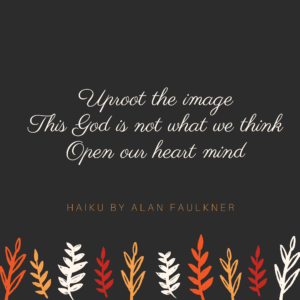
My Spiritual Roots by Karen Rushen O’Brien
When Laura Waters sent out an invitation for offerings about our “spiritual roots” for this edition of our newsletter, I was intrigued. I immediately thought to myself “What are my spiritual roots?”
At 12, my family moved to South Korea, where I encountered Buddhism in frequent visits to Buddhist temples, and the experience of Buddhist belief and practice. At the same time, I also was prepared for confirmation by Filipina Catholic sisters who involved me even in their life and work in the slums, teaching me about Catholic social justice, teaching not only in theory but also in practice. Sure, we brought food and clothing to those in need and threw Christmas parties for orphans, but the sisters made sure we learned that systemic change, not just charity, was what our Catholic faith demanded of us. Both the encounter with Buddhist teaching and meditation, and Catholic social action and accompaniment informed much of my adult life’s work. So are those my spiritual roots?
Or do those roots go back further into childhood, when my Catholic faith was informed by my “immigrant roots”—experiencing Catholicism from the perspectives of my Irish, Italian, Polish and Lithuanian immigrant relatives, and the ethnic parishes we attended, with their different saints days, festivals, rituals, liturgies and spiritualities. I remember the Italian nuns, who made sure it was Italian, not Latin, that we were learning for mass, and who made the best pizza for school lunch! I remember, too, over at the Polish church, bringing our food baskets to be blessed on Easter Saturday, where a corpus of Jesus lay in a glass “coffin” at the foot of the altar, waiting to resurrect on Easter Sunday—an unnerving sight for a child. And I remember my grandfather’s books of Irish saints and prayers, and how he loved to get fresh well water from his own “holy well”—found right there in Bristol, Connecticut and not the less “holy” for it! Such a rich and diverse childhood where “difference” was celebrated and marked me as “difference friendly” for the rest of my life–were those my spiritual roots?
Then I got thinking—my spiritual roots, the ones truly informing me at this junction of the spiritual journey, go back even further than that. My spiritual roots can be found in my “deep” childhood, and are “pre-denominational.” They can be found in my early experiences of love, play and nature.
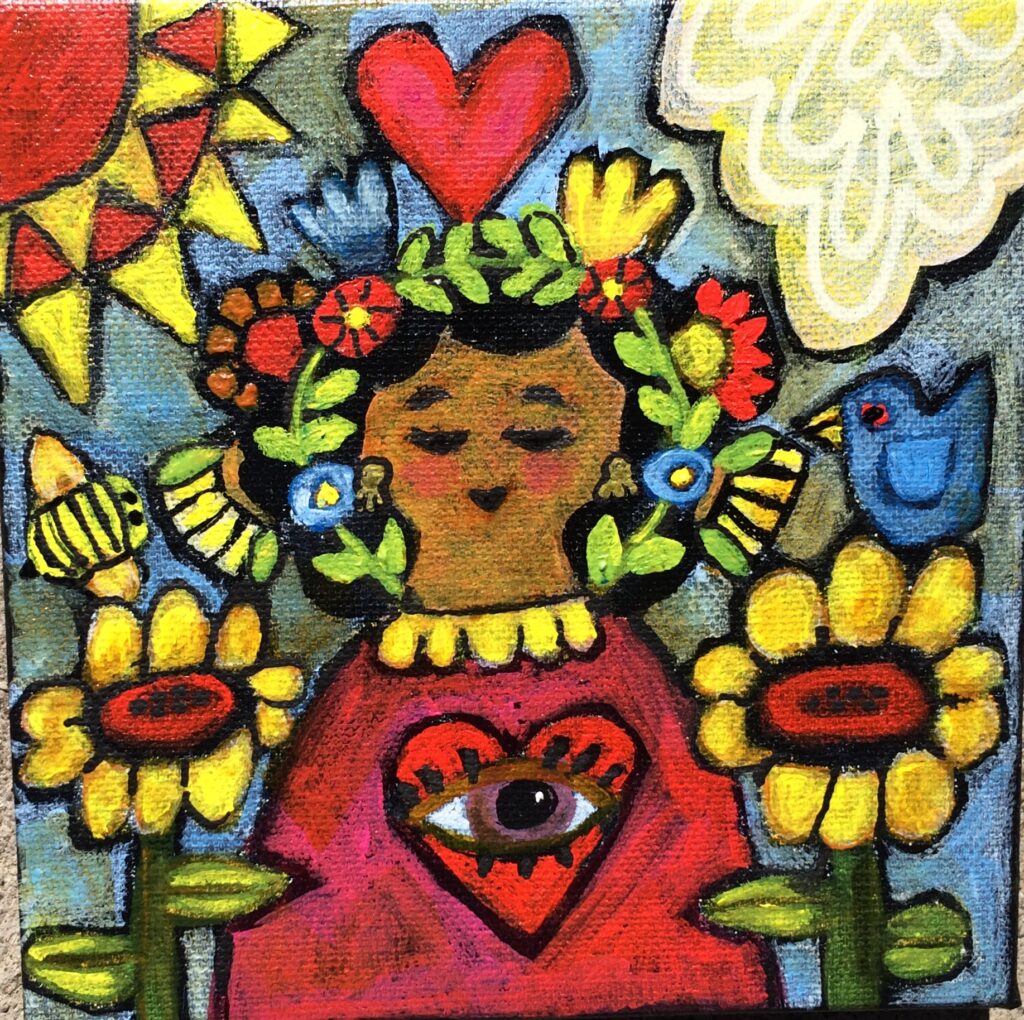
Art by Karen O’Brien
I knew love in many ways– through grandparents who cuddled and spoiled me, and my little kitty, who loved to curl up in my lap and purr. My 64 color box of crayons introduced me to play, which created joy, creative energy and ongoing creativity within my developing being. I knew wonder, beauty, abundance and mystery through the natural world that surrounded us in rural central Connecticut where I grew up, hills covered with mountain laurel, fiddle ferns, lady slippers and Indian peace pipes, thickets of blueberries, and babbling brooks filled with salamanders, crayfish, minnows, frog jelly and tadpoles. In my heart of hearts, Heaven is still a little slice of Connecticut, and probably will be always…
All these early childhood experiences were charged with something Eternal, with Deep Love, Creative Energy, Silent Peace, Natural and Created Beauty; realities and energies that, even though my child’s mind couldn’t formulate the words, my child’s heart knew to be “the stuff of God”.
As I am aging, I am less and less interested in the writings and ideas of various wisdom traditions, or the theological knowledge of particular denominations and faith traditions. Not that these weren’t important, and that such study wasn’t a major part of my spiritual development. It’s just that the Divine is so much more “present” in the experience of loving and being loved, in creating and appreciating that which has been created, and in nature and the natural world, which more and more speaks to me not as living metaphors of the Divine, but as the Living Divine itself.
I am consciously trying to allow myself to simply “be” in that space of raw, privileged intimacy with the Divine that is the way of simple, child-like faith, rooted to and in the Divine in a deeply spiritual way, not as an innocent child, but as an aging woman seeing with new eyes the age-less spiritual roots and gifts the Divine surrounds us with everywhere and in all things, all our years…
My Roots by Mark Kirkpatrick
When I was seven years old, I was sent to a boarding school (a prep school) and then from the age of thirteen, to a public school (Stowe). Throughout this period, there was compulsory worship in the school chapel. This worship was under the auspices of the Church of England. Even if one was a member of another religion, one had to attend these services. The headmaster of Stowe happened to be a practising Christian and this gave the school a Christian ethos, to an extent. I got to know the Chaplain of the school quite well and kept in touch with him after I left Stowe. This was the beginning of my Christian journey.
I made a number of false starts in my journey – partly because no-one in my family was a Christian and I had nothing to hold onto, from a spiritual point of view. When I was 25, a friend suggested that I join Holy Trinity Brompton in London – a lively Anglican evangelical church. At this point, my Christian life blossomed and I never looked back.
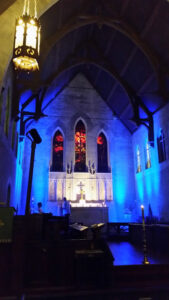
Taize, Photo by Laura Waters
Even though I was only there for two years, it was an important time. I spent nine months at a Bible school in California before joining Scargill House, an Anglican community in North Yorkshire. I was there for four years. This period has shaped my Christian journey. The leader of the community influenced me hugely, as he was able to hold together several strands of Christianity simultaneously.
Since leaving Scargill, I, too, have held several strands of Christianity in my journey. Over the years I have gone on retreats at monasteries and have kept an interest in Christian communities. About a year ago I started joining in the morning Meditation Chapel group (someone in WCCM told me about it). Since joining this group I have valued the discipline of meditating with others on a daily basis. The group includes some very thoughtful people. I am interested in the fact that people from various faith traditions belong to the group.
I have recently formally left my local Anglican church and am in the process of exploring the local Catholic Church but have not yet actually attended any services there yet. My spiritual journey, like many others, has changed direction over the years. Meditation Chapel has been part of that journey.
ORGANIC GARDEN by Ruth Williams
This moment is a seed;
The present holding eternity;
The trust;
The love;
The gratitude;
The forgiveness;
The peace;
My heart.
Your heart.
The heart of Mystery
It grows into what we love to
imagine
What we think about
What we hope for
What we stand under and
hold up
What we honor,
Walk slowly,
Bow often
Wash hands
To be clean
Ready
For service
The seed will grow when all the conditions are
ready
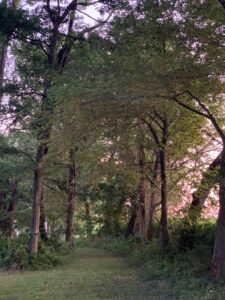
Photo by Lawrence Gabriel Muller
AN INNER ROOM RETREAT by Brian O’Donnell
It is amazing where our spiritual paths take us. Prior to Covid-19 I had registered for a weekend retreat which was cancelled as a result of the ensuing pandemic. I was bitter over this cancellation but had no idea what the next few months would bring. The Meditation Chapel was just ahead of me on my path.
As a result of Covid-19, I now found myself spending most of my day at home as New York was put on pause. As the virus progressed and the news seemed to worsen every day, I turned to my centering prayer practice which consisted of one morning sit. In our inner rooms we find peace and this was a good start to my day but I needed to tap into this Source throughout my day. I used my new spare time to explore the internet and discovered many groups dedicated to centering prayer and the contemplative life. There is a wealth of information out there on the work of Keating, Merton, Rohr, Nouwen, and many more. I decided to increase my knowledge of this work. Through this seeking, I started to find a way to stay positive or God-conscious amongst negativity.
This seeking also led me to the online Meditation Chapel. The calendar on the chapel website offered virtual group prayer and meditation all day every day. I needed to check this out. I soon learned there were many people participating in this practice using this online platform. Many were doing this long before the pandemic and had an abundance of wisdom, not to mention an aura of peace. Here was a place where I could sit with a group of welcoming people for an hour of centering, lectio divina, and holy sharing – a daily virtual retreat. Here was a place of peace, an escape from the outside noise of negativity.
I soon found myself in the chapel up to three times a day. My bitterness over a postponed May weekend retreat became a distant memory. “Be still and know that I am God” became much clearer to me. I enjoy listening as others share how the selected readings are speaking to them individually. I believe it is God speaking to us through each other.
I really needed this pause to slow down pray and reflect with these people put on my spiritual path. The chapel has been and will continue to be a blessing to me. As I am writing this the world is starting to come out of the pause and is now in the midst of the tragic events caused by the wrongful death of George Floyd, a black man, by a white police officer. We need to be still and God conscious. We need to pray for and seek peace for ourselves and the world.
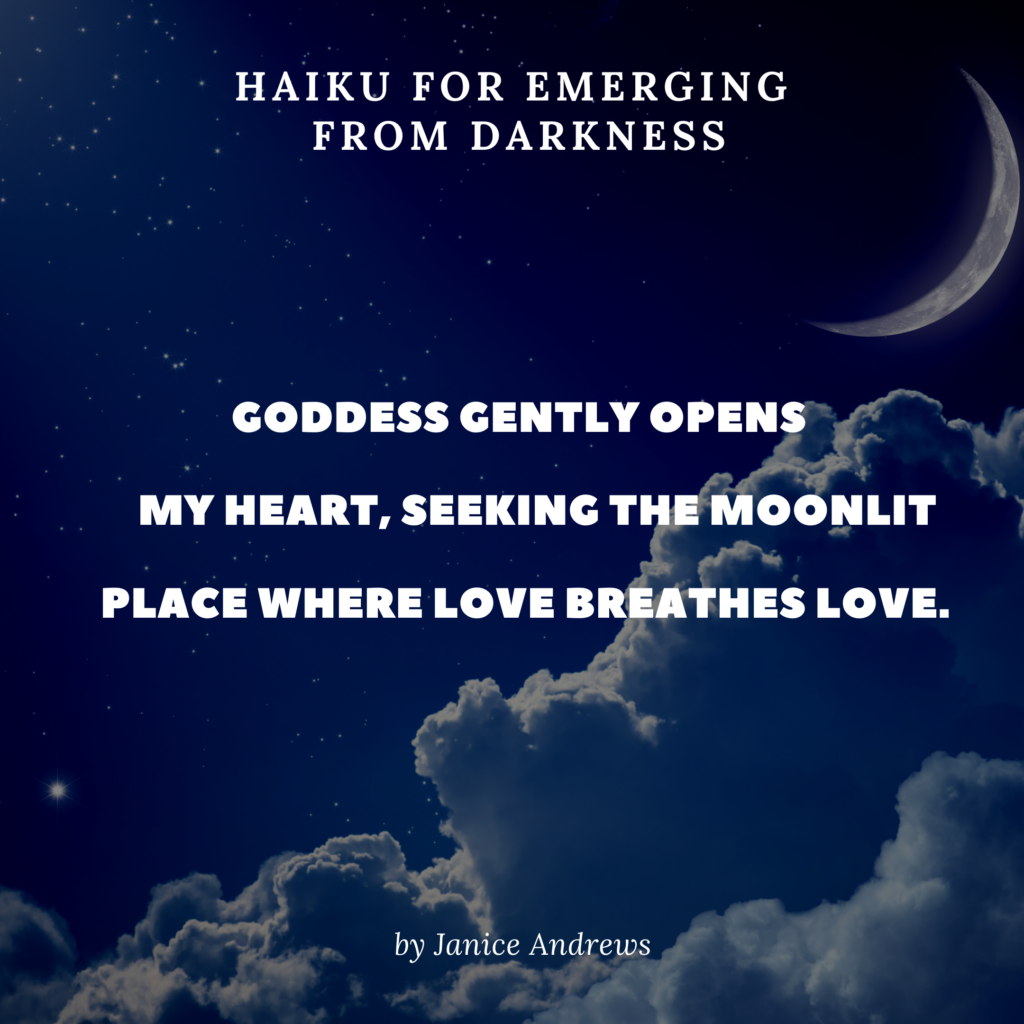
ROOTED IN PRACTICE (LECTIO DIVINA) by Marcia Stoner
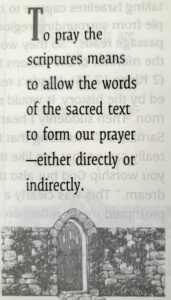
St. Augustine described the essence of Lectio Divina as getting to know “God’s story” and also OUR part in the story—and then trying to know the story better and better.
Basil Pennington’s book, Lectio Divina, tells us this is a traditional monastic practice of scriptural reading, meditation, and prayer intended to promote communion with God and to increase the knowledge of God’s word.
The two Latin words are translated, “Divine Reading.” The texts are to be studied as the living word of God.
According to tradition, there are four steps in Lectio Divina:
- Read
- Meditate
- Pray
- Contemplate
Thus we view the bible passages with Christ as the key to their meaning. We enter into and share the peace of Christ, rather than dissecting it.
The practice was first established by Benedict of Nursia in the 6th century. The Second Vatican Council recommended Lectio Divina to the general public, in the 20th century. Here’s how we “feast on the word”:
-take a bite (Lectio)
-chew on it (Meditatio)
-savor the essence (Oratio)
-digesting it and making it part of the body (Contemplatio).
Through Lectio Divina, we achieve a calm state of mind – “Be still and know that I am God” (Ps.46:10).
Being Present – The Inner Sanctuary by Corey Krupowicz

Photo by Francine Lombard
The present moment is open to all of us if we choose to enter it. Paying attention to our present moment may take a bit of training to recondition years of mindlessly attaching to and believing in thought.
Within this reconditioning, the present moment offers us a sanctuary for the practice. The breath is a very simple way of entering the present moment without having to alter our lives. Our breathing is an ongoing process that invites us at any moment to enter the realm of presence. One can enter the interior space and open to the awareness of consciousness without the bombardment of thoughts.
Over time the more we enter and live from the space of the present moment, the more we are able to put the thinking mind off to the side for a while. To be able to manage thought and thinking in such a way can be a valuable skill to have and teach. Entering this sanctuary is like entering our homes and removing a coat. The same is true for entering our sanctuary of the present moment, but we remove the heavy jacket of thought and bring our attention to sense awareness. The breath is a great starting point because one can know, “Oh, I am thinking about the past or the future. Let me re-calibrate and have the breath as my focal point.“ With practice we are able to expand the time thought is absent. At any moment throughout the day we can be rooted in our present moment awareness.
Enter the sanctuary as much as you can – it is your dimension to play with and enjoy. For this reconditioning to take hold, adopt this practice as a daily priority and the thinking mind will become secondary. Our inner sanctuaries can be discovered within our footsteps, breathing, touch sensations, or any sensory awareness as the focal point. This shift from thinking to sensory awareness is a restful rootedness in the “I AM” awareness.
Our inner landscape is a safe abode where practice of awareness can be cultivated. Within all this one of the more important points of this work is one’s commitment to the practice of awareness. Think of it as collecting bits of awareness and depositing them within our practice bank. The more we commit to the practice the more awareness develops and strengthens, allowing the thought-chains to dissolve.
This work takes time as will any reconditioning. It is helpful to cultivate an awareness practice that stimulates calm, mental reprieve. The more we enjoy the work of relying less on thought and paying attention to our awareness within each moment, the more it will just be the way we live each day of our lives. A sabbatical from thoughts is our possibility, we just need to commit to resting in our sanctuary within.

Photo by Laura Waters
Movement of Breath by Tissy Rose Palack
There is one gate of entry and exit
Entry through the nostrils, filling the lungs
Exit through the nostrils, emptying the lungs
Entering to energize every cell
Exiting, cleansing, every cell
Where the breath moves in and out
Felt in the rise and fall of abdomen
Felt in the extension and contraction of muscles
Felt the flowing presence, even in stillness
Air moves in
Air moves around
Air passes by
Never the same in two moments
Always Anew and always Here
Awareness is what observes
Awareness is what allows
Awareness is what accepts
To awareness, I offer this breath…
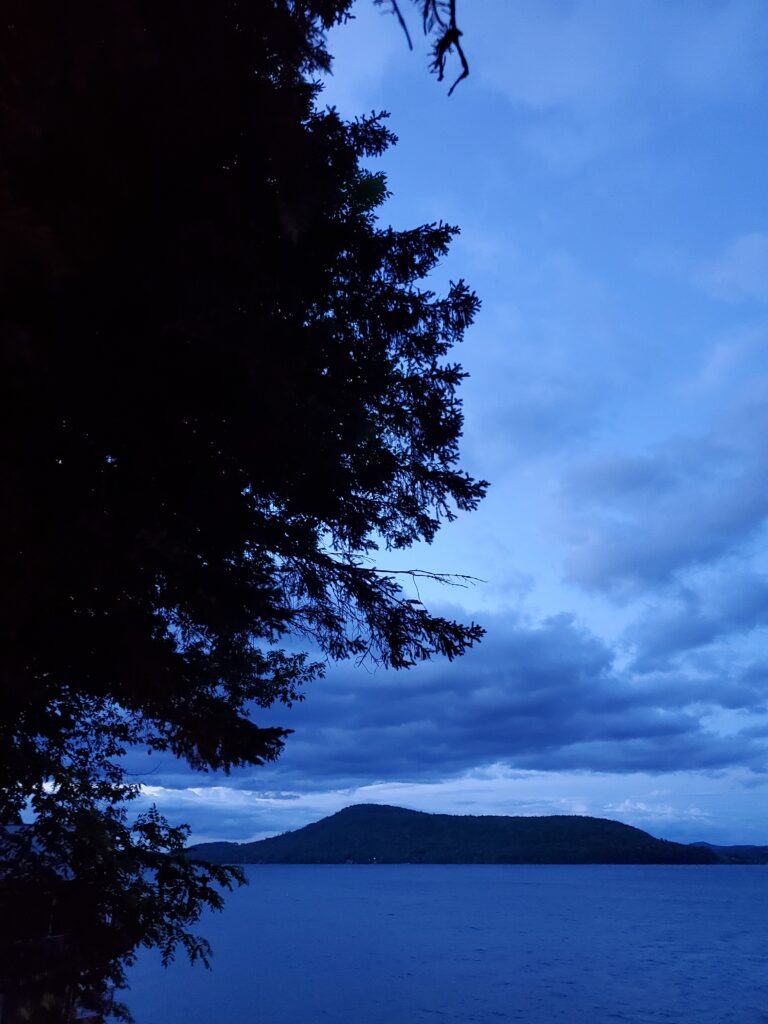
Photo by Karen McNamara
|
WELCOME TO OUR NEW FACILITATORS AND GROUPS AT MEDITATION CHAPEL Facilitators: Jose Oliveira Groups: What: Presbyterian Church in Claremont Meditation Group What: Contemplatives in Conversation What: Centering Prayer & Reading Group What: “Do Not Worry” and Lord’s Prayer by Jesus, 15-Minute Mindfulness Meditation from Matthew 6 What: Centering Prayer & Spiritual Journey video series What: Centering Prayer (in English) What: Centering Prayer Group What: Centering Prayer Group What: Meditation and Conversations about Loss & Grief What: Centering Prayer with the Stations of the Cosmic Christ |
Contemplating with the Cosmic Christ – a new offering in the Meditation Chapel
The Cosmic Christ is way of seeing the risen and living Jesus Christ in his fullness, both with us 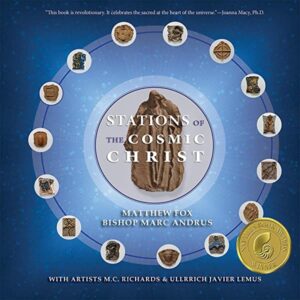 in our individual and community struggles, and present to the entire creation at the same time. The term “Cosmic Christ” was brought into the language of the contemporary Church by theologian, activist, and Episcopal priest Matthew Fox.
in our individual and community struggles, and present to the entire creation at the same time. The term “Cosmic Christ” was brought into the language of the contemporary Church by theologian, activist, and Episcopal priest Matthew Fox.
Five years ago, Fr. Fox and Bishop Marc Andrus undertook an exciting, generative project – creating a book of the Stations of the Cosmic Christ, a counterpart to the traditional Stations of the Cross. The Stations of the Cross focus on the last hours of Jesus of Nazareth’s earthly life, on his suffering and death. The Stations of the Cosmic Christ turn our attention to the numinous events of Jesus’ life, such as his birth, Baptism, Resurrection, and Ascension.
Matthew and Marc each wrote a meditation on each Station of the Cosmic Christ, and the book uses unique art images, created for the Stations, to illustrate each one. The illustrations are photographs of a series of abstract clay sculptures by noted American poet, essayist, and potter M.C. Richards (d. 1999). Richard’s precious sculptures are inspired by the “I AM” sayings in the Gospel of John, each of them considered a Station of the Cosmic Christ. The remaining images are photographs of sculptures by Javier Lemus, a contemporary Salvadoran artist who now lives in San Francisco. Javier’s art is of an entirely different character than that of Richards’; where hers are spare and monochromatic, Javier’s are brightly colored and use organic forms to bring out the essence of each station. Together the images shed light not only on the stations but invite the viewer to search for a more comprehensive, interconnected meaning.
Stations of the Cosmic Christ won two book awards from Nautilus in 2018, Special Honors as Best of Small Press, and Gold Award for Religion/Spirituality of Western Thought.
Matthew Fox is one of the most influential theologians working today. The author of more than thirty books, he has written works that are current-day classics, such as The Coming of the Cosmic Christ and Original Blessing. Matthew is as much an activist as a theologian and was one of the faith leaders prominent in the Occupy Movement. Bishop Marc Andrus was first consecrated as Bishop Suffragan in the Diocese of Alabama where he concentrated his ministry on racial reconciliation, environmental justice, and the renewal of Christian pilgrimage. Bishop Marc is one of the leading voices from faith bodies in climate change and environmental justice and heads the Presiding Bishop’s delegation to the United Nations climate change conferences. Marc is married to ecological entomologist, climate activist, and international public health expert, Sheila Moore Andrus, PhD.
Each session of Contemplating with the Cosmic Christ will begin with a few minutes of gazing at one of the Stations of the Cosmic Christ, followed by reading a related paragraph from Matthew’s and Mark’s meditations. After the image and the text have been brought into the center of the virtual gathering, the group will enter twenty minutes of silence in the tradition of Centering Prayer. The session will end with sharing what has been brought to the group by the grace of the Holy Spirit.
{See “new groups” listing for meeting information}
ONENESS: THE SECRET EMBRACE – Thomas Keating’s Poetry with Cynthia Bourgeault
Cynthia Bourgeault presents “Oneness: The Secret Embrace,” Thomas Keating’s final gift to the world, as expressed through the poetry of his later years. This is from three Zoom calls held April 30 – May 2, 2020 during the COVID-19 pandemic, sponsored by Contemplative Outreach of South Africa and Contemplative Outreach International, with support from The Trust for the Meditation Process. Cynthia deftly and gracefully presents an evolved view of the being and theology of Fr. Thomas through a review of eight poems from the book “The Secret Embrace.” Some videos have a pause for Centering Prayer, where more than 2,000 people prayed in silence together from over 59 countries, the largest gathering of the worldwide community to date. For more on Centering Prayer and Contemplative Outreach go to http://www.contemplativeoutreach.org
Access this gift here : ONENESS
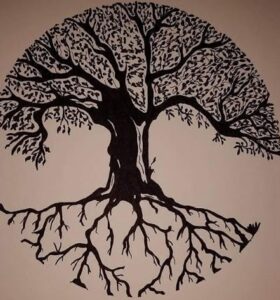
Art by Mariea DeRosia
The following story is based on an ancient Chinese folktale. It has been adapted by a number of contemporary cultures. I first heard it in a sermon many years ago.
~ Bob Brown
☯︎
The emperor was aging and he wanted to prepare for a graceful succession.
He called his two sons and explained the situation. The first son declared, “Father, obviously I’m the oldest so I should be the next emperor.”
The second son listened but began to speak as soon as the oldest brother finished. “Father, although I am not the oldest I am by far the wiser. I should be the next emperor.”
The emperor thanked his sons for their input, excused them, then turned to his courtier. “I will be leaving for a journey tomorrow. Please do your best to keep an eye on things while I’m gone.”
A few days later, the emperor appeared in the doorway of a one-room schoolhouse in a far-away village. “May I come in?” he asked the teacher.
“Of course,” the teacher answered.
The emperor walked to the front of the room. “My friends,” he began, “I am going to give each of you a seed. Please find a pot, some soil, and give your seed proper amounts of sunshine and water until I return in 30 days.”
One little girl received her seed and after school ran home to show her father. “Look, Daddy, a seed from the emperor. He wants me to take good care of it until he comes back.” She found an empty pot, filled it with soil, pushed the seed into the soil with her thumb, covered the space with soil, and watered it gently.
Each day she would run home from school and pour a little water into the pot. After three weeks, nothing had sprouted.
“Daddy, nothing is growing. All the kids are talking about their plants, and I have nothing!”
“My darling,” her father said gently, “sometimes we have to be patient. Let it be so for now.”
On the thirtieth day, she took her barren pot to school. All the other kids had their pots, too. Theirs all had little green shoots of various kinds. She felt miserable.
As the bell tolled the beginning of the school day, the emperor walked into the classroom. The teacher greeted him with a bow. “Your imperial majesty, it is an honor to welcome you back. I present to you our class and their plants.”
The emperor walked up and down the aisles, looking closely at the pots and what was growing in them. When he had concluded visiting each desk, he strode to the front of the room.
“Thank you, ladies and gentlemen, for taking good care of my seeds. I noticed one empty pot.”
The children all turned to the little girl with the barren pot. Some laughed loudly. Some giggled and covered their mouths. The little girl hung her head in shame.
The emperor spoke again, “What I haven’t told you is that all the seeds which I gave you were boiled. None of them could have produced anything. This little girl patiently cared for her seed without putting a new one in its place. She will be the next emperor.”
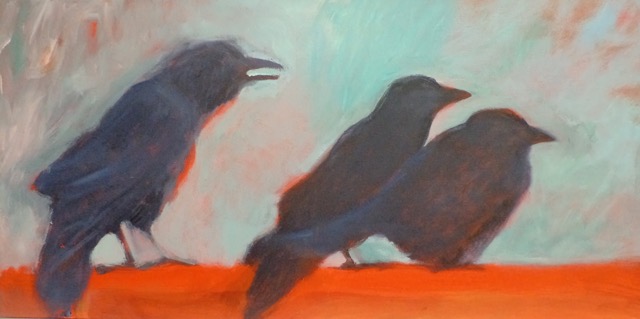
Teaching Moments by Janice Andrews
TAO OF BEING TOGETHER by Lawrence Gabriel Muller
Paint it black, friend, or yes, you can make that green,
Red, white and blue, know you sure what we do mean.
Catch the sound, a leprechaun of swing named Thelonious:
Monk-master of the ivories, in a holy jazz vanguard supreme.
There is no need for you to fall, dear, so I might move higher.
Let us ascend together, but first marry the very ground here,
This Earth we walk upon; take the Way that goes to Jerusalem.
As Merton once stood still in Louisville, witness to the Light.
So we sing with all low-bending fruits of Ireland and America,
Taste the tune of freedom, play upon bodhran and saxophone.
For a solitary marmot home is a paradise of leaves and grass,
Our road to Damascus, laurels and thunder meet and embrace –
From fabled China to now, Lao Tzu is being together in the Tao:
Since one we are, rehearse awhile, until our Sun rises in the East.
Copyright © 2020 Online Meditation Chapel, All rights reserved.
